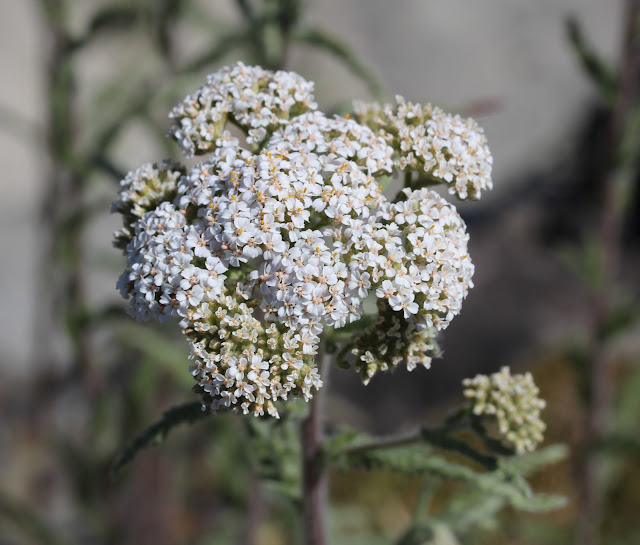The invasive Himalayan blackberries are blooming, which means it's time
to look for bees carrying that taupe coloured pollen they provide. When
you remove invasive plants, it's important to replace them with a collection of the native plants they have likely displaced. So at this time
of the year that means hairy honeysuckle, trailing blackberry, oceanspray, sedum and snowberry. At
Jack's Point in Nanaimo, these plants will be in full bloom in a few
days and there will be a crazy amount of bees on them. There are many worker bumble bees out on Vancouver Island now and a few male bumble bees are also starting to appear. We also witnessed herons and eagles feeding in the bay at low tide.
The oceanspray buds and blossoms are frothy and delicate and when fully opened they attract numerous species of native bees. Andrena mining bees seem to love them.
I was happy to see that hairy honeysuckle has an affinity for climbing arbutus trees. This relationship is beautiful to witness. Long-tonged bees, butterflies and moths love suck the nectar from these tubular flowers. Short tongued bees cheat and bite holes in the corollas. I was also excited to see Sedum spathulifolium blooming at the base of some arbutus trees. It makes a fabulous drought tolerant ground cover and bees love the bright yellow flowers.
As the snowberry blossoms appear, the hum of the forest edge increases in volume as all sizes of bees drink the sweet nectar.
This is also a great year for Rocky Mountain clearwing moths which lay their eggs on snowberry shrubs.
There is still a bit of shortspur seablush in bloom, which is also a favourite of Rocky Mountain clearwing moths and bees.
The tiny shiny Ceratina carpenter bees seem like the right size to feed on these hooker's onions, which are one of the most beautiful allium species I have ever seen.
There were also a few flowers I'm not familiar with--excited to get to know them!
This yarrow was also blooming, with very silvery hairy leaves.
I was thrilled to see this bee mimic robber fly (Laphria fernaldi). It's difficult to see, but it was carrying another insect as its prey.
We were really lucky to witness an eagle munching on a large crab. I can attest it was a messy eater! Bits of crab fell onto the forest floor to feed scavengers and add compost to the rich soil.
Darren counted 25 herons feeding in the bay at low tide. It was such a beautiful day to go bee and bird watching at Jack Point. I feel so much gratitude to witness such spectacular beauty.




















No comments:
Post a Comment